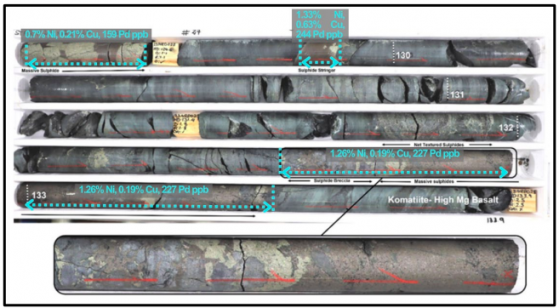NickelSearch Ltd (ASX:NIS) is growing confident about its greenfield targeting strategy at the Carlingup Nickel Sulphide Project near Ravensthorpe in Western Australia after assays from a diamond drill program confirmed massive nickel sulphide mineralisation at the project’s Sexton Prospect.
Assay results from two diamond drill holes completed at Sexton last month confirmed the nickel, copper and platinum group element (PGE) content of the nickel sulphides with intersections including:
- 23NRD028 – 1 metre at 1.26% nickel and 0.19% copper from 132.5 metres; and
- 23NDD030 – 1 metre at 0.76% nickel and 0.23% copper from 148.5 metres.
Intersection of nickeliferous sulphides in drill hole 23NRD028, with massive sulphide intersections highlighted.
Proof is in the pudding
“It’s encouraging to have the assays validate the visuals previously logged, confirming that we have massive nickel sulphide mineralisation at Sexton,” NickelSearch managing director Nicole Duncan said.
“We know from the DHEM surveys that the conductive plates continue as far as we can assess with the survey tool, meaning the mineralisation is open to us down-plunge.
“This alignment of the conductive plates at Sexton with confirmed mineralisation is a solid basis on which to test for further positive results beyond the limit of the DHEM surveys.
Results give confidence
The company believes Sexton’s nickel sulphide mineralisation has been “remobilised” from a distal primary nickel sulphide source.
“Sexton was identified with historical drilling but it is becoming clear that the plunge was not correctly interpreted, the structure was missed and the target was abandoned.
“Armed with fresh analysis performed since ASX listing, NickelSearch has been able to reconsider the historical information, and each of the six holes we have drilled at Sexton has intercepted nickel sulphide.
“This gives us confidence to continue our work on other greenfield targets across Carlingup, plus also plan further drilling at Sexton to vector in on potential higher grades and thicker zones.”
Plan of the Sexton area showing the DHEM plate models plunging shallowly to the east-southeast.
Another discovery
Separately at the B1 high-priority target, assay results for the diamond hole 23NDD031 intersected a 40-metre interval of sulphides from a depth of 285.2 metres.
This hole was also drilled in July to a depth of 342.9 metres.
Although relatively narrow, B1's mineralised horizon continues for hundreds of metres, particularly to the southeast.
Further exploration of this mineralised horizon will be carried out, including geochemical and geophysical work and drilling.
Next steps
NickelSearch is planning to follow up on the confidence-building results at Sexton as well as at B1, where past results from electromagnetic surveys at the latter will be reviewed for further ultrafine soil sampling.
Planning is also underway for drill programs at Carlingup’s other greenfield targets, beginning with Lipple and Wadley in early October if weather permits.
Concurrently, a lithium rock chip sampling program is ongoing, targeting priority areas defined by a recent desktop study.
Samples have been submitted to the laboratory for assaying.
Read more on Proactive Investors AU
